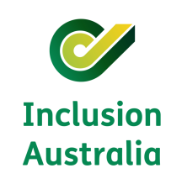What is work-based learning and does it have results?
Work-based learning is a combination of two proven strategies for increasing employment of people with disability: work experience and vocational training. Essentially it is:
placement [in a job or work experience] accompanied with supported training in a real world context (Wakeford & Waugh, 2014, p.18).
Work-based learning has been shown to have results for people with intellectual disability who learn well in situ (Crawford, 2011; Wehman et al. 2018; Lewis et al., 2011a), given that, for people with intellectual disability:
transfer of training from one setting (e.g., classroom) to another setting (e.g., workplace) is a particular impediment because of difficulties in generalisation of skills (Lewis et al., 2011a. p.108).
Various researchers have argued that work-based learning, or ‘place then train’, is preferable to, and more successful than, the ‘train then place’ model, which is based on the idea that job seekers have to slowly acquire skills through a sequence of preparatory then vocational courses and prove their work ‘readiness’ (Cocks & Thorensen, 2013). As argued by some researchers, the work-based training model (or place then train)
is particularly useful for those with autism and intellectual disability where generic skills development is not easily transferred from the classroom and into the workplace. Many young people with intellectual disability can struggle with classroom-based vocational training, and learn better through practical, hands-on experience. With this in mind, resources can be better utilised by training the person in the specific role, for a specific employer and on-the-job; rather than spending years ‘waiting’ for someone to becoming ‘work ready’ (Wakeford & Waugh, 2014, p.18)
An Australian study has found that people with disability who undertook part or all of an apprenticeship or traineeship experienced higher levels of employment, wages and job durability than a similar cohort of people with disability who did not commence traineeships or apprenticeships but started a first job (Lewis et al., 2011a).
It is not only vocational skills that are able to be built using a place-then-train approach. Evidence from school to work transition programs has also shown that the opportunity to engage in direct, hands on, work placement experience while in secondary school also builds a range of work-related, non vocational skills, or ‘soft skills’, such as greeting co-workers and workplace communication, that are a factor in gaining open employment and to being successful once in the workplace (Wehman et al. 2018).
Ingredients to support work-based training
A small set of Australian research has identified a range of ingredients that support successful work-based training models. Ingredients include:
- Provide ‘sufficient and appropriate support to adjust the inhibiting structures in the physical and social environment’
- Form ‘partnerships with disability employment services, which specialise in providing on-the-job support for workers with disabilities’
- Form partnerships with ‘group training organisations, which specialise in employing apprentices and trainees through host employers’ (Cocks &Thorensen, 2013, p.12).
The most significant ingredient to success has been identified as:
supportive and understanding individuals or agencies willing to provide flexible, individualised support tailored to the individuals’ needs… [such as] emotional and practical support …[in] training and workplace environments. Support came from friends and family, supervisors and co-workers, disability employment services, group training organisations and other employers/host employers, TAFE or other registered training organisations and disability liaison officers in TAFE or other organisations, assessors and trainers (Cocks &Thorensen, 2013, p.12).
Common work-based training models
School to work transition programs
Australian School Based Apprenticeship and Traineeship (known as SBAT, ASBAT or ASBA)
ASBATs enable young people to undertake part time paid employment and training in an apprenticeship or traineeship while they are still in secondary school (usually years 11 and 12). There is evidence to suggest that people with disability complete apprenticeships and traineeships at only slightly lower rates than their peers without disability (Ball & John, 2005; Lewis et al. 2011a), though it should be noted that completion rates overall are not good (Cocks & Thorensen, 2013).
Apprenticeships and traineeships have been shown to be beneficial pathways for people with disabilities, particularly for people with intellectual and learning disabilities (Lewis, Thoresen & Cocks 2011a, 2011b), for obtaining qualifications and employment as they combine training and education with practical work (Cocks & Thorensen, 2013, p.7).
Ticket to Work
Ticket to Work is a national program of the National Disability Services, Australia, that supports networks of partners in local regions who work to provide opportunities for young people with disability to build employability while they are at school (mainstream or special schools) (ARTD Consultants, 2019). Partners include schools, Disability Employment Services, TAFE/RTOs, employers, disability services and others, who
work together to provide young people with access to career development, workplace preparation, work experience, vocational skills and Australian School Based Apprenticeships and Traineeships (ASbATs). Essentially each Local Network supports young people with disability to participate in the same ‘typical’ transition to employment activities that their non-disabled peers generally partake in (Wakeford & Waugh, 2014, p. 6).
Ticket to Work includes a range of career and employment development activities conducted in school:
- Vocational Education and Training at secondary school
- Australian School based Apprenticeships and Traineeships (ASbAT)
- Work experience/placement
- Career development through customised employment techniques
- After school work
- Self-employment during secondary school (microbusiness) (ARTD Consultants, 2019, p. 8).
Ticket to Work participants (around 53% of those being young people with intellectual disability) have been supported to undertake the majority of their vocational training ‘on the job’ as much as possible ‘demonstrating competency by actually undertaking tasks in the workplace setting’ which leads to better employment outcomes for young people with intellectual disability (Wakeford & Waugh, 2014, p.23).
Two evaluations of Ticket to Work have evidenced that it is a successful model, with participants being more likely to be employed (64%) than the comparison group (33%), as well as be more likely to complete year 12, undertake post secondary education, be more socially active and more independent (ARTD Consultants, 2019).
Internships
Internship models that provide specialized support and skill development for people with intellectual disability have been shown to lead to open employment (Wehman et al. 2018). There are several internship models in Australia, that have evidenced outcomes for people with intellectual disability. Some are described below.
Project Search
The Project SEARCH Transition-to-Work Program originated in the United States with a primary target of assisting young people with intellectual disability. It is a ‘business-led, one-year employment preparation program that takes place entirely at the workplace’ (https://www.projectsearch.us/transition-to-work/) combining classroom-based training (onsite in the workplace), career exploration, and a range of work experience through worksite rotations. In the original model in the US, students in the last year of secondary school, rotate through three different internships of 10-12 weeks each. The focus is on intensive on-the-job training supplemented by classroom learning (Wehman et al. 2018). Project Search has been widely evaluated and achieves on average employment rates of 83% (Christensen et al, 2016). The model has been extended to multiple countries including the UK, where it is part of a ‘supported internship’ approach. These programs are ‘based mainly on employers’ premises, with some time in college or a classroom in the workplace. Support throughout the study programme is provided to both the young person and the employer through a Job Coach’ (https://www.preparingforadulthood.org.uk/downloads/supported-internships/project-search-a-model-for-supported-internships.htm). Project Search or ‘supported internships’ for young people with intellectual disability have been running in the UK for approximately 8 years with significant employment results (https://www.stgeorges.nhs.uk/work-with-us/work-experience-at-st-georges-university-hospitals-nhs-foundation-trust/project-search/).
Similar programs, adapting the Project Search model, have been run in Australia.
The Integrated Practical Placement (IPP) program
The Integrated Practical Placement (IPP) program has been run twice by the Royal Children’s Hospital Melbourne and Holmseglen (TAFE) in 2018 and 2019 for 10-12 students with ‘learning disability’ undertaking Certificate 1 in Work Education (https://wiseemployment.com.au/success-stories/laura-reaps-benefits-of-the-integrated-practical-placement-program-a-joint-collaboration-with-the-royal-childrens-hospital-holmesglen-institute-and-wise-employment/). Students completed three nine week placements during the year including in the areas of human resources, medical records, allied health, volunteer and family services, the early learning centre, kitchen, mailroom and equipment departments (https://holmesglen.edu.au/About-Us/News/Student-job-outcomes-on-the-rise-with-The-Royal-Children-s-Hospital-placement-program/).
An independent evaluation found that 80% of students of IPP attained paid employment or paid traineeships (compared to 35% who completed the Certificate in the usual TAFE setting without being part of the IPP program), as well as experiencing other outcomes such as increased confidence, independence and maturity (White et al., 2018). Recommendations of the evaluation suggest that this ‘gold standard’ program is suited to large scale employers of 3000 of more which affords a variety of placement opportunities for students (White et al., 2018).
References
ARTD Consultants. (2019). Ticket to Work Post School Outcomes. Report for National Disability Services, Final Report, Sydney, Author, https://tickettowork.org.au/media/uploads/2020/03/03/ticket-to-work-post-school-outcomes-final-2019.pdf
Ball, K. & John, D. (2005), Apprenticeship and traineeship completion rates, NCVER, Adelaide, https://vital.voced.edu.au/vital/access/manager/Repository/ngv:2519?query=apprentice+completion+rates+ball&queryType=vitalDismax
Christensen, J.J. & Richardson K. (2017) Project SEARCH workshop to work: participant reflections on the journey through career discovery. Journal of Vocational Rehabilitation, 46(3):341–54.
Cocks, E. & Thoresen, S.H. (2013) Barriers and facilitators affecting course completions by apprentices and trainees with disabilities, Adelaide, NCVER.
Crawford, C. (2011). The Employment of People with Intellectual Disabilities in Canada: A Statistical Profile from https://irisinstitute.files.wordpress.com/2012/01/intellectual-disability-and-employment_iris_cr.pdf
Lewis, G.; Thoresen, S.H. & Cocks, E. (2011a), ‘Post-course outcomes of apprenticeships and traineeships for people with disability in Western Australia’, Journal of Vocational Rehabilitation, vol.35, no.2, pp.107—16.
Wakeford, M., & Waugh, F. (2010). ‘Ticket to Work’ An employment and transition model for students with a disability, Cheltenham, Authors, http://www.tickettowork.org.au/wp-content/uploads/2014/05/Ticket-to-Work-Scoping-Report-2010.pdf
Wakeford, M. & Waugh, F. (2014). Transition to employment of Australian young people with disability and the ‘Ticket to Work’ initiative, National Ticket to Work Network, http://www.tickettowork.org.au/research_evaluation/transitions-employment-australian-young-people-disability-ticket-work-initiative/
Wehman, P., Taylor, J., Brooke, V., Avellone, L., Whittenburg, H., Ham, W., . . . Carr, S. (2018). Toward Competitive Employment for Persons with Intellectual and Developmental Disabilities: What Progress Have We Made and Where Do We Need to Go. Research and Practice for Persons with Severe Disabilities, 43(3), 131-144. doi: 10.1177/1540796918777730
White, G.; Kiegaldie, D. & Hunter, S. (2018). The integrated practical placement program: a program of social inclusion in the workplace for young people with disability, Melbourne, The Royal Children’s Hospital Melbourne and Holmseglen.
The authors would like to acknowledge the usefulness of Crosbie, J.: Murfitt, K.; Hayward, S. & Wilson, E. (2019), NDIS Participant Employment Taskforce. Literature review: Employment and economic participation of people with disability, Burwood, Deakin University, as a review of similar literature that provided initial guidance.


